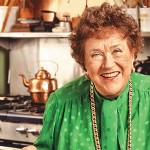Learning Styles: Julia Child Thrived as Visual Learner
 I recently took a mini-vacation with my oldest daughter. We spent a few days together in sunny Montauk, NY, enjoying the beach and delighting in the spectacular views of the Atlantic Ocean. While my daughter and I always enjoy our time together, I was also blessed to have Julia Child join us.
I recently took a mini-vacation with my oldest daughter. We spent a few days together in sunny Montauk, NY, enjoying the beach and delighting in the spectacular views of the Atlantic Ocean. While my daughter and I always enjoy our time together, I was also blessed to have Julia Child join us.
As I lay on the beach in Montauk, I read about Julia’s celebrated life in Dearie: The Remarkable Life of Julia Child, by Bob Spritz (2012). My book, Being Visual, details the needs, struggles and strengths of visual, kinesthetic learners, so imagine my delight when I read that Julia, famous chef, author and television personality, was a visual, kinesthetic learner!
It seems Julia’s mother recognized her need for visual, tactile learning and enrolled her in a Montessori kindergarten. Her biographer shared that Julia was “sent to a nearby Montessori school that emphasized hands-on activities—seeing and feeling and doing—as opposed to the imaginative play of most kindergartens. She mastered the school’s physical drills intended to develop a youngster’s hand-eye coordination: hammering round pegs into round hole, squares into squares: organizing containers so they fit inside one another; rearranging alphabet blocks in their proper order.”
It seems that while Julia had an excellent education, including a college degree from the prestigious Smith College, she didn’t excel in the academic classroom. Julia didn’t consider herself “an intellectual type,” which caused her some insecurity; she longed for purposeful work that suited her. Eventually, right-brained, kinesthetic Julia moved to Washington, and then overseas during WWII, to manage the strategic operations office of the OSS. Her divergent thinking abilities, natural curiosity and discipline were well-suited for the unique position.
Some years later, Julia learned to cook, collaborated on writing her debut cookbook, Mastering the Art of French Cooking, and starred in the first educational television show. This visual, kinesthetic, “non-academic” woman had a remarkable career that changed the attitudes, beliefs and behaviors of an entire culture and set a food revolution whose impact is still felt today.
Julia Child is just one example that there are many kinds of smart in this world, and we “non-academic”, visual, kinesthetic types have a lot to contribute—we may even change the world!
 |
Bette FetterFounder and CEO of Young Rembrandts and Author of Being Visual |










